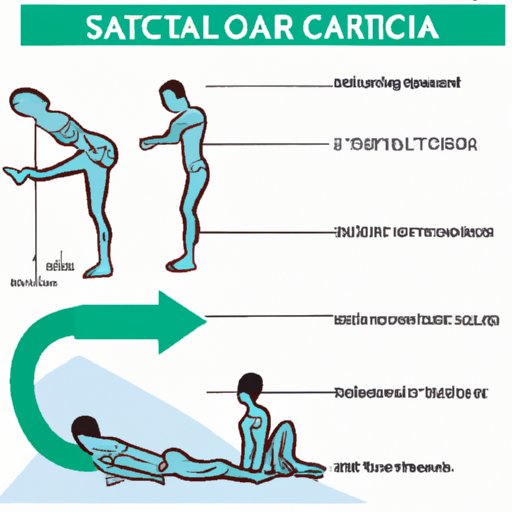
Introduction
Suffering from sciatica can cause immense discomfort and disrupt daily activities. Sciatica is a condition that results from the compression or irritation of the sciatic nerve, which runs from the lower back to the legs. The pain can range from mild to severe and is often accompanied by tingling sensations and numbness. This article aims to provide a comprehensive guide to managing sciatica pain naturally, offering tips on stretching exercises, massage therapy, heat and cold therapy, natural remedies, chiropractic adjustments, yoga poses, and pain-management strategies.
Stretching Exercises for Sciatica Relief
Stretching exercises can loosen the muscles and relieve the tension that compresses the sciatic nerve. Here are some stretching exercises that can help reduce sciatica pain:
- Seated spinal twist
- Knee-to-chest stretch
- Standing hamstring stretch
It’s essential to perform these exercises correctly and under the guidance of a trained instructor. Here’s how you can perform them:
- Seated spinal twist: Sit on a chair, cross your right leg over your left knee and slowly turn your torso towards the right. Hold for 30 seconds and switch sides. Repeat 3-5 times on each side.
- Knee-to-chest stretch: Lie on your back, bend your knees and bring them towards your chest. Hold the back of your thighs and pull your knees closer to your chest. Hold for 30 seconds and release. Repeat 3-5 times.
- Standing hamstring stretch: Stand with your feet apart, bend forward and reach towards your toes. Hold for 30 seconds and release. Repeat 3-5 times.
Massage Therapy for Sciatica Pain
Massage therapy can improve blood circulation, alleviate inflammation, and reduce muscle tension, providing relief from sciatica pain. Here are some massage techniques that can help:
- Trigger point therapy
- Soft tissue mobilization
- Deep tissue massage
It’s crucial to perform these massages correctly or seek help from a professional. Here’s how you can carry out self-massage:
- Trigger point therapy: Locate the painful area in your lower back or legs, apply pressure until the pain subsides, and release. Repeat until you feel relief.
- Soft tissue mobilization: Using your fingers, massage the soft tissues surrounding the affected area, applying moderate pressure. Repeat for 5-10 minutes.
- Deep tissue massage: Using your knuckles, massage the deep tissues surrounding the affected area, applying firm pressure. Repeat for 5-10 minutes.
Heat and Cold Therapy for Sciatica
Heat and cold therapy can reduce inflammation and alleviate sciatica pain. The best ways to apply heat or cold therapy are:
- Hot/cold compress
- Warm bath
- Heating pad
When applying cold therapy, use a cold pack wrapped with a towel and apply it for 20 minutes at a time. When applying heat therapy, use a heating pad and set it at a low to medium temperature for 20 minutes at a time. Never apply heat or cold therapy directly to the skin.
Natural Remedies to Relieve Sciatica Pain
Natural remedies like turmeric, ginger, and fenugreek can help reduce inflammation and pain naturally. Here’s how you can use them:
- Turmeric: Mix turmeric powder with water or milk and drink it twice a day.
- Ginger: Boil sliced ginger in water, strain, and drink the ginger tea twice a day.
- Fenugreek: Soak fenugreek seeds in water overnight, strain, and drink the water on an empty stomach in the morning.
It’s essential to incorporate these remedies into your daily routine and consume them regularly to see a noticeable difference.
Chiropractic Adjustments for Sciatica
Chiropractic adjustments, such as spinal manipulation, can help alleviate sciatica pain and improve mobility. Here are some tips on finding a qualified chiropractor:
- Ask your doctor or healthcare provider for a referral
- Read reviews and ratings online
- Ensure that the chiropractor is licensed and certified
During the treatment, the chiropractor will manipulate your spine and joints to alleviate pain and improve your range of motion. Chiropractic adjustments can take several sessions before you experience relief.
Yoga Poses to Alleviate Sciatic Nerve Pain
Yoga can help reduce sciatica pain by loosening muscle tension, improving flexibility, and promoting relaxation. Here are some yoga poses that can help:
- Pigeon pose
- Seated forward bend
- Reclining big toe pose
It’s essential to perform these poses under the guidance of a trained yoga instructor. Here’s how to do them:
- Pigeon pose: Start on all fours, bring your right knee towards your right wrist, and stretch your left leg behind you. Lower your body towards the ground and hold for 30 seconds.
- Seated forward bend: Sit with your legs straight in front of you, bend forward and reach for your toes. Hold for 30 seconds.
- Reclining big toe pose: Lie on your back, bend your right knee and bring your right leg towards your chest. Hold your big toe with your right hand and extend your right leg towards the ceiling. Hold for 30 seconds and switch sides.
Pain-Management Strategies for Sciatica
Simple lifestyle changes can help minimize sciatica pain and prevent flare-ups. Here are some pain-management strategies:
- Regular exercise
- Maintaining good posture when sitting and standing
- Taking breaks during long periods of standing
It’s essential to incorporate these strategies into your daily routine and avoid activities that exacerbate pain.
Conclusion
Sciatica pain can be disruptive and uncomfortable. However, there are many natural remedies and pain-management strategies that can help alleviate it. In this article, we have covered stretching exercises, massage therapy, heat and cold therapy, natural remedies, chiropractic adjustments, yoga poses, and pain-management strategies that can relieve sciatica pain. Remember, if the pain persists, it’s crucial to consult a doctor or health professional for a personalized treatment plan.




